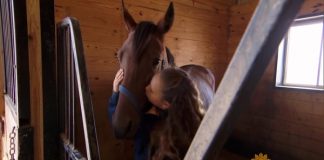“Keep a straight line from elbow to bit,” is something that most equestrians hear in their riding careers. It’s simple advice but it’s also a guideline that carries quite a bit of weight both literally and figuratively. A horse’s ability to perform well and work harmoniously with a rider depends on him distributing his weight equally over his front and hind legs. This level of balance at all gaits is the cornerstone for comfort, responsiveness, and success at any endeavor. It is an important goal for every horse and rider team to work toward, but holding your hands too low will prevent it from happening.
However, we’ve all heard, “Low hands for a low head.” So, it makes sense that holding your hands as low as they can go will encourage your high-headed horse to lower his neck. However, your horse’s high head carriage isn’t the source of the problem. It’s a symptom of a problem with his balance. It’s a sign that your horse isn’t carrying his weight evenly over his four legs as he travels. Forcing his neck down further complicates things for your horse and makes it impossible for him to restore his balance. Over time the quality of his gaits will deteriorate as he learns to compensate for his downhill frame by shortening his stride, lifts more from the knee and hock, and disengages his hindquarters.
This unnatural gait results in muscle overuse, underuse, and strain. It increases the load on your horse’s forelegs, hooves, and joints. Dropping your hands can also backfire by compelling your horse to lift his head higher. His neck function as a counter weight – as his forehand becomes heavy it elevates (creating a hollow frame and a tense and stiff body) and as his forehand lightens it lowers into a relaxed position.
By maintaining a consistent forearm-wrist-hand angle you increase your horse’s comfort and give him the space to find his natural balance. If you’re uncertain how to find proper alignment from your elbow to your horse’s mouth, try this trick: With your palms facing each other point with your index fingers. Then raise or lower your forearms until your fingers are pointing directly at the corners of your horse’s mouth – making sure your wrists are relaxed and straight.
If you ride your horse on a loose rein, the rules are the same. Follow the line to the mouthpiece of bit instead of your reins. Also be aware that your horse is always in motion and making large and small adjustments to his head and neck position as he changes gait, shifts his attention, or modifies his balance. Maintaining a consistent forearm-wrist-hand-bit line means staying in alignment with your horse’s head wherever it may be in any given moment.
Click here for more What’s Wrong with This Picture videos.
Dale Rudin is a CHA-certified riding instructor and clinician with a mindful and balanced approach to horsemanship and riding.
www.un-naturalhorsemanship.com





